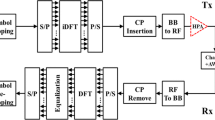Abstract
This paper proposes a new interleaving rule, with which a new IBF (IBF, intertwined bridge function) is generated. Not only does the new intertwined bridge function have a zero correlation zone, but also its cross-correlation performance is ideal. An ultra-wideband system is introduced, which uses the intertwined bridge functions as the spreading code. The sequence of interleaved bridge function with zero autocorrelation bridge area and zero cross-correlation zones can better reduce multiple access interference and multipath interference. It is shown by the simulation results that the ultra-wideband systems using the interleaved bridge function as the spreading sequence have better error rate performance.















Similar content being viewed by others
References
Li, Z., & Zhang, Q. S. (1983). Introduction to Bridge functions. Electromagnetic Compatibility, 25(4), 459–464.
Zhang, Q. S., & Li, Z. H. (1982). A new orthogonal multiplex system. In International telemetering conference, San Diego (pp. 175–183).
Slimane, B. S., & Abdullatif, G. (2000). Multi-carrier CDMA system using Bridge functions. In Vehicular Technology Conference Proceedings, Tokyo (pp. 1928–1932).
Zheng, Y. (2011). Designing of a spreading-spectrum sequences based on the bridge function-restricted research. Beijing: Beijing University of Chemical Technology.
Tang, H. (2005). Some physical layer issues of wide-band cognitive radio systems (pp. 151–159). Baltimore: New Frontiers in Dynamic Spectrum Access Networks.
Rieser, C. J. (2004). Biologically inspired cognitive radio engine model utilizing distributed genetic algorithms for secure and robust wireless communications and networking. Blacksburg: Dissertation. Virginia Tech (pp. 182–189).
Di Benedetto, M. G., & Giancola, G. (2006). Understanding ultra wide band radio fundamentals. Beijing: Electronic Industry Press.
Guo, L. (2010). Design and application of a special spread spectrum sequences. Beijing: Beijing University of Chemical Technology.
Dilmaghani, R. S., Ghavami, M., & Allen, B., et al. (2003). Novel UWB pulse shaping using prolate spheroidal wave functions. In Personal, indoor&mobile radio communication proceedings, London (pp. 602–606).
Jitsumatsu, Y., & Kohda, T. (2008). Prolate spheroidal wave functions induce Gaussian chip waveforms. In ISIT, Toronto (pp. 1363–1367).
Zang, W., Shen, H., & Kwak, K. S. (2007). Pulse series based UWB CR system. Cross layer design, Jinan (pp. 169–172).
Acknowledgments
This paper is supported by the Science & Technology Plan Projects of Changchun city (No. 2013023) and the National Key Basic Research Program of China (973 Program: No. 2015CB453000).
Author information
Authors and Affiliations
Corresponding author
Rights and permissions
About this article
Cite this article
Yu, Y., Gao, K. A Novel IBF and Its Application in Ultra-Wideband Systems. Wireless Pers Commun 84, 2289–2305 (2015). https://doi.org/10.1007/s11277-015-2539-3
Published:
Issue Date:
DOI: https://doi.org/10.1007/s11277-015-2539-3




